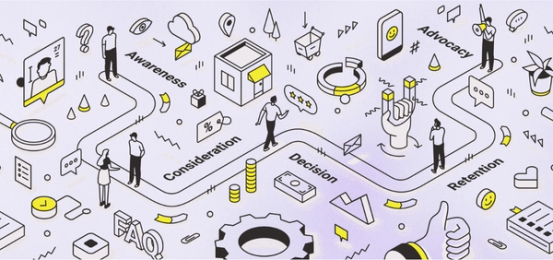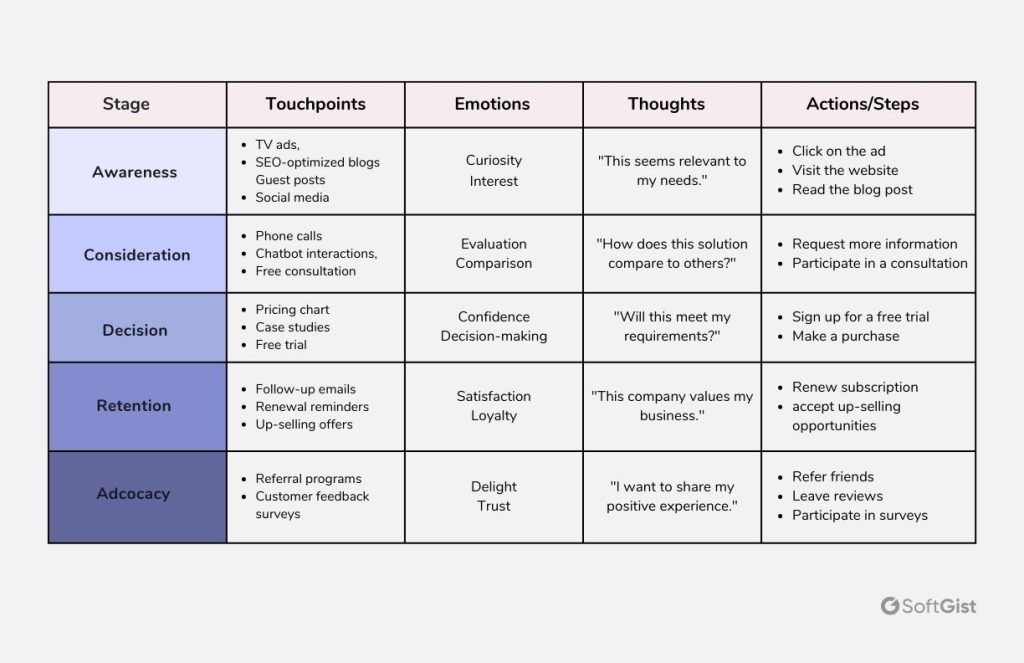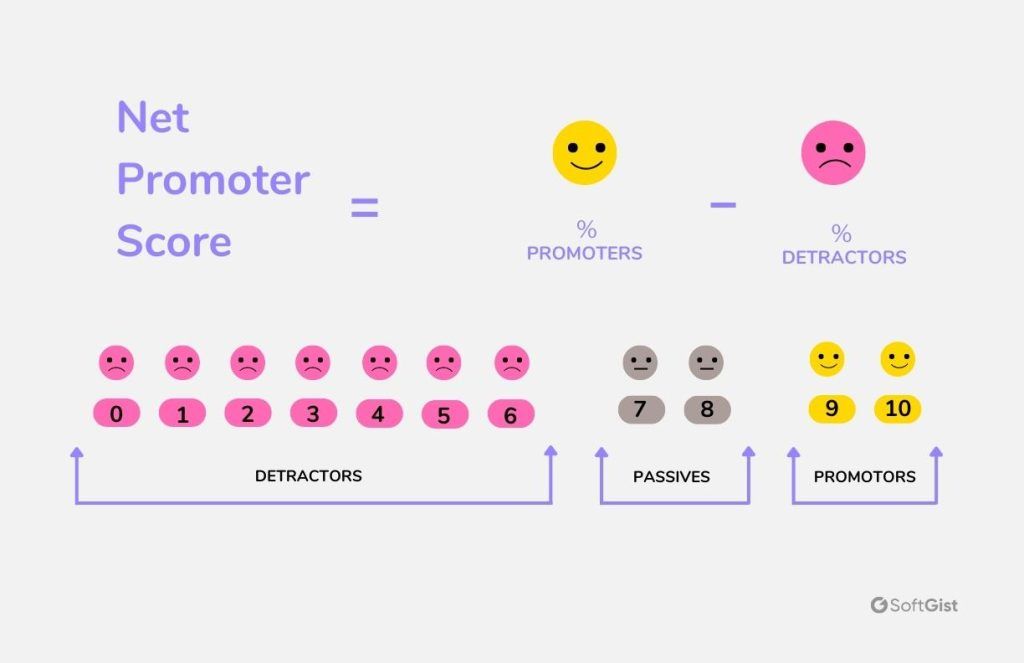B2B Customer Journey: An Ultimate Guide to Turn Prospects into Loyal Customers
Updated June 2, 2024
Published June 7, 2023

In the Business-to-Business (B2B) sector, the importance of the B2B customer journey cannot be overstated. It’s not merely about the first impression but a steady sequence of compelling interactions that transforms prospects into loyal customers.
We’re about to explore this B2B customer journey – a journey that’s rarely linear or predictable, but understanding it is vital. Mastering this journey is key to not only attracting potential customers but also retaining them, ensuring they don’t drift towards your competitors.
Let’s get into the details!
What is B2B Customer Journey: A Definition
The B2B customer journey encompasses all the interactions a potential buyer has with your business, products, or services – this includes before, during, and after making a purchase. Spread across multiple channels, these interactions or ‘touchpoints’ build up to create the overall experience for your customer. On average, before a B2B customer makes a buying decision, they’ll interact with at least 13 content pieces.
It’s critical to distinguish between a B2B customer journey and a buyer’s journey. While the buyer’s journey maps out the process a customer goes through from recognizing they have a problem to purchasing a solution, the B2B customer journey focuses specifically on the customer’s experiences with your business or service.
Recognizing how prospects interact with your business at varying touchpoints lets you identify areas needing improvement and potential hurdles they might face. This knowledge enables you to tailor your marketing, sales, and support strategies to meet your customer’s needs more effectively, which can help to boost customer acquisition and retention.
5 Stages of a B2B Customer Journey
Every B2B customer journey can be thought of as a progression through a series of stages. Although these stages can vary depending on the specific context of the business or industry, they often follow a similar overall pattern. In this section, we will explore a commonly referenced model that consists of five primary stages: awareness, consideration, decision, retention, and advocacy.

Stage 1: The awareness stage
Did you know 71 percent of B2B customers begin their buying journey with a generic search, instead of a brand-specific search? At the awareness stage, your lead doesn’t want to commit to any product or business. Instead, they’ve identified a need or challenge within their business and attempted to understand it further through research.
In this phase, the aim is to establish your company’s visibility to ensure potential customers take notice.
Tactics that can enhance this awareness encompass Search Engine Optimization (SEO), paid digital campaigns, active social media presence, sponsoring content, and leveraging the power of organic word-of-mouth marketing.
The focus here isn’t to drive immediate purchases. Instead, it is to expand visibility and lend credibility to your business by showing your prospects that you understand their problem.
Types of content that help generate awareness include:
- White papers
- Gated or non-gated long-form content
- How-to articles
- Informational videos
- e-books
- Infographics
Remember that this is your prospects’ first impression of you — it is critical not to be sales-y; instead, focus on making a compelling impression by delivering content brimming with value.
Stage 2: The consideration stage
The prospect is now well-informed about their problem, ready to explore different strategies and approaches (& vendors) to solve it.
Your prospect will analyze how your solution holds up with your competition. Elements they will look at include price, product specs, and reviews. Prospective clients may try to reach out through channels like phone calls, emails, or social media inquiries to gather more details about your offerings – prompt responsiveness is crucial. As Gartner’s study suggests, your sales team’s interaction may constitute approximately 5% of a client’s decision-making duration.
The consideration stage tends to be the longest, as it is very resource-intensive for the lead.
The content at this stage shouldn’t be blatantly promotional. Your focus should be to nurture your lead further, providing information that indirectly makes the prospect realize that your product or service is the best solution and fit for their business.
Examples of the consideration stage-specific content include:
- Product-focused webinar
- Case studies
- Product-specific blogs
- FAQ
- Vendor comparison and buying guide
Stage 3: The decision stage
The prospect has enough information about their problem and analyzes all possible solutions. At this stage, they have narrowed the options to a select few businesses that they think will best fit their needs — all left now is for them to decide whether to purchase your product or service.
Customer reviews and testimonials can effectively bring the winning spotlight to your business and push the competing vendors to the background. 75 percent of B2B buyers use social media to bolster their purchasing decision. Thus, social proof of any kind can act as a catalyst to trigger conversion.
In B2B, prospects typically involve colleagues and stakeholders in their decision-making process when selecting a solution for their needs. Therefore, your content in this stage should effectively establish your product as the ultimate solution to their problem. It should emphasize why your product is the best option and why making a purchase now should be an obvious choice.
Types of content that fits the decision stage include:
- Case studies
- Customer testimonials or reviews
- Discounts
- Free trial
- Live demos
Stage 4: The retention stage
By this stage, your prospect has given your business their stamp of approval by converting into a buyer.
But your job isn’t over yet. Studies indicate that acquiring new customers can be five to seven times more expensive than retaining an existing one. A high retention rate enhances profitability per customer and minimizes losses to competitors. Thus, it’s prudent to construct a seamless post-purchase strategy that solidifies customer loyalty to your business.
Some measures you can implement to enhance your customer retention rate include:
- Ask your customers for feedback regarding their experience with your product and your business (this data can provide valuable insights for optimizing overall customer experience)
- Publish tutorials that show how to use and get the most out of your products
- Offer a dependable and seamless customer support experience
- Incentivize renewals or repeat purchases through discounts or reward points
- Publish an exclusive newsletter to keep customers connected to your business even post-purchase
Stage 5: The advocacy stage
During this stage, your customer is so over-the-moon about the product that they become advocates for your business. Content clients may voluntarily provide positive feedback and suggest your services to their professional and personal circles. Such organic promotion is a highly efficient and affordable way to draw in new clients.
How do you transform current customers into advocates?
Shower them with exceptional value, excellent customer service, and personalized experiences. Naturally, it’s vital to maintain excellent quality in your offerings and ensure they deliver as promised.
In addition, you should actively encourage your customers to advocate for your company by providing them with appealing incentives such as:
- Referral Programs: Customers get rewards like discounts or free products for referring new customers to your business.
- Advocacy Programs: Customers earn rewards for promoting your business through reviews, social shares, case studies, etc.
- Discounts or Freebies: Customers receive price reductions or bonus items, incentivizing them to continue using your product and sharing it with others.
- Social Media Shout-outs: Customers are publicly recognized on your company’s social media platforms, building community and showcasing their testimonials or posts.
In essence, these strategies create a mutual benefit, rewarding customers for their advocacy and helping to expand your business reach.
Building and Optimizing a B2B Customer Journey Map
The B2B customer journey is longer and more convoluted than the B2C customers’ journey. Reasons?
- Multiple stakeholders are involved in purchasing decisions; reaching a consensus among everyone involved takes time.
- B2B products have a higher complexity and cost than B2C products. This necessitates a prolonged decision-making process involving thorough research, vendor evaluations, and consideration of long-term implications.
With the proliferation of digital interaction channels, streamlining customer experiences can feel similar to trying to tame a bull. However, B2B customer journey maps can help bring some methods to the madness.
What are customer journey maps?
A B2B customer journey map is a visual storyboard of every step a prospect or customer takes before achieving a goal or interacting with your business.
A B2B customer journey map gives you the unique opportunity to:
- Gain actionable insights: This map lets you experience the entire B2B customer journey from your prospect’s perspective. You can see what your customer is thinking, feeling, and doing through their interactions with your business across the different stages of the B2B customer journey.
- Ensure cohesiveness across different channels: Journey maps can help you determine how your marketing efforts spanning every digital channel are interconnected. It allows you to imbue consistency and coherence in messaging and content delivery, leading to a seamless customer experience.
- Identify optimization opportunities: Content journey maps help uncover friction points and bottlenecks customers may experience at different junctures. These insights allow you to address any roadblocks to seamless customer experience and enable intelligent allocation of marketing budgets, focusing resources on areas that drive the most value.
- Improve critical KPIs: By optimizing weak or problem areas in journey maps, businesses can improve key performance indicators (KPIs) such as customer acquisition, retention, renewal rate, and loyalty, all of which can have a tremendous impact on your bottom line.
- Minimize marketing costs: Content journey maps minimize the risk of wasteful spending by showing where to divert resources for maximum returns and where to cut corners.
- Deliver journey-specific marketing efforts: Maps allow you to dissect customer experiences into different B2B customer journey stages. This way, you can create relevant and personalized marketing efforts catered to meeting customers right where they are on the journey and gently funnel them to keep going. This tailored approach improves engagement and increases the likelihood of conversion.
Overall, B2B customer journey maps provide businesses with a macroscopic and microscopic view of their prospect’s path from discovering your business to becoming a paying customer, and beyond. B2B Customer journey maps can help develop customer-centric strategies, optimize processes, and deliver a seamless and engaging experience to your audience.
Creating B2B Customer Journey Maps
A few building blocks of customer experiences form the bedrock of a robust, customer-centric B2B customer journey map. These are:

Goal identification
Before architecting your B2B customer journey map, define the desired actions or outcomes you want your customers to perform at the end of each series of interactions. These goals will serve as the end-points for your B2B customer journey map, representing the ideal outcomes of each customer interaction. Some examples of desired actions in a B2B context include:
- Encouraging customers to complete a transaction
- Encouraging customers to renew their subscription or contract
- Motivating existing customers to spread the word about your products and services in their social and professional circle
- Encouraging prospects to sign up for a free trial to see if your product solves their needs risk-free
- Encouraging customers to upgrade their subscription
- Convincing interested prospects to send a request for more information about your product or service
- Encouraging customers to sign-up for your newsletter
With the defined goals, you can reverse engineer the interactions that will lead your customer to perform these actions.
B2B Customer journey stages
Creating a journey map that truly reflects your business necessitates understanding the unique B2B customer journey stages your business offers. While we have already highlighted the conventional five B2B customer journey stages – awareness, consideration, decision, retention, and advocacy, there might be additional stages specific to your business model, known as micro-stages.
For instance, if you’re a SaaS firm employing a subscription model (be it monthly or annually), the ‘renewal’ stage becomes a crucial element in your post-purchase B2B customer journey. During this stage, your marketing and sales initiatives would be strategically designed to decrease customer churn rate.
The inclusion of these micro-stages like ‘renewals’ in your B2B customer journey map contributes to a more precise depiction of the experiences that shape your B2B customer journey.
Each B2B customer journey is distinctive to its business. Therefore, your B2B customer journey map should echo this uniqueness. The crucial factor is to comprehend your customers and their requirements at every stage, which will guide you to customize your marketing and customer service efforts effectively.
Touchpoints
In B2B, a touchpoint refers to any point of contact where your customer encounters your business. These include clicking (or even just seeing) your ad, discovering your content on search engine pages, website visits, phone calls, emails, attending webinars, social media posts, downloadables, and more.

Identifying these touchpoints is a critical step in creating your B2B customer journey map, as they form the ‘steps’ your customer will take on their journey. Every B2B customer journey stage will encompass its own set of touchpoints. For example, in the awareness stage, a lead may reach out to you after finding an optimized article for a keyword that reflects the prospect’s pain point.
Here are some of the B2B customer journey-specific touchpoints that may apply to your business:
- Awareness: TV ads, SEO-optimized blogs, guest posts, sponsorships, banner ads, social media posts, and websites.
- Consideration: Phone calls, requests for more information, chatbot interactions, free consultation, white paper, buying guides, and long-form content that discusses solutions.
- Decision: Customer testimonials, pricing chart, case studies, checkout process, demonstration, and free trial.
- Retention: Follow-up emails, subscription renewal discounts, up-selling or cross-selling opportunities, and renewal reminders.
- Advocacy: Referral programs, social media shares, reviews, and customer feedback surveys.
You may need digital properties such as websites, landing pages, social media profiles, or forums to facilitate touchpoints.
Including the channels and touchpoints in your B2B customer journey map will help determine the most influential touchpoints that need optimization to funnel more customers to the desired actions.
Emotions, thoughts & actions
Your customer’s emotions, thoughts, and actions at each touchpoint provide valuable insight into their overall experience and thus are key components to consider when creating your B2B customer journey map. It is essential to examine what your customers think, feel, and do as they encounter different touchpoints. To gather such data and insights, research, interviews, and feedback-collection tools are invaluable.
Here are some questions to think about:
Emotions:
- How are customers feeling at each touchpoint? Are they satisfied, frustrated, excited, or confused?
- What factors contribute to these emotions? Are there pain points or moments of delight during interactions?
Thoughts:
- What are customers thinking during their interactions with your business?
- Are they considering alternatives or seeking more information?
Actions/Steps:
- What actions or steps are customers taking at each touchpoint?
- Are they purchasing, contacting customer support, requesting a demo, or sharing feedback?
Some methods and tools you can use for gathering this information include:
- Surveys and Interviews with open-ended questions to encourage responses to provide detailed insights
- Implementing feedback tools like Net promoter score (NPS) and Customer Effort Score (CES) to gather data about customer satisfaction and effort level with using your product or service

- Using web analytics and tracking tools to assess customer behavior at critical touchpoints
- Evaluating click-through rates, conversion rates, and similar metrics to determine what needs to be improved
By familiarizing yourself with customers’ thoughts, feelings, and actions, you can refine the customer journey and create meaningful and seamless experiences.
Customer persona
Understanding who your customers are is a crucial step in creating a realistic and effective B2B customer journey map. Buyer personas are in-depth, composite portrayals of your target customers, capturing key characteristics and traits influencing their buying decisions and behaviors.

To develop these personas, conduct rigorous user research involving surveys and interviews. In addition, leverage your existing customer data to gather valuable persona-related insights such as motivations, pain points, preferences, behaviors, and feelings.
Once you’ve developed your customer personas and identified the journey stages, touchpoints, and the corresponding emotions, thoughts, and actions associated with each stage, the next step is to integrate these elements.
Keep in mind, each persona may embark on a unique journey, making it crucial to delineate individual journeys for each persona. This process involves projecting these personas onto your B2B customer journey map.
By doing so, you can visualize the varied ways customers might traverse through the journey stages and engage with different touchpoints. Examining your customer journey from this comprehensive perspective can help highlight potential friction points and uncover opportunities for personalization. These insights serve as a valuable guide in developing strategies that can enhance the overall customer experience.
How to Optimize B2B Customer Journey Maps
If your B2B customer journey map isn’t bringing the results you want, consider implementing the following optimization strategies:
Re-examine your target persona
Ensure your customer persona is well-researched and accurately represents your target audience. Conduct market research again and identify any gaps in your understanding of your customers and refine your persona.
If your persona is incorrect or not detailed enough, it can lead to creating journeys that aren’t relevant to your demographic.
Evaluate existing touchpoints
Assess whether the necessary touchpoints exist at each B2B customer journey stage to facilitate appropriate interactions and relationship building.
Consider how your target audience prefers interacting with your business and ensure that the touchpoints align with their preferences. Some important touch points relevant to B2B businesses include social media, video, audio, text-based content, landing pages, reliable communication channels (email, phone, or live chat), and paid advertising campaigns.
Invest in lead nurturing
Recognize that not all leads generated during the awareness stage will immediately convert into paying customers.
If you see weak conversions, consider implementing a stronger lead nurturing process that effectively qualifies and nurtures leads, increasing the likelihood of conversion. This process may involve a series of value-filled and persuasive emails, personalized content, or targeted marketing campaigns. Customers who are emotionally connected to a brand hold over 306% higher lifetime value than those that are simply satisfied.
Focus on understanding customer needs and expectations to design a solid lead nurturing process that builds trust and encourages conversion.
Continue to update your B2B customer journey
Customer journey maps are not static entities. They change as customer behavior, trends, pain points, and needs shift.
Your B2B customer journey should always reflect those changes, or you could risk having your product or service ignored or go obsolete.
Conclusion
In conclusion, comprehending and optimizing your B2B customer journey is vital for nurturing long-term customer relationships and fostering brand loyalty. Remember, this journey is more than just a path to purchase; it’s a roadmap to customer satisfaction and business growth.
Building accurate customer personas and mapping out the B2B customer journey might require significant time and resources, but the investment will yield dividends in the form of increased customer satisfaction, loyalty, and business expansion.
As you progress, remember to keep your customers at the heart of your strategies, exceed their expectations, and ensure their experiences are seamless at every touchpoint. This guide should serve as a stepping stone toward creating more engaging and impactful B2B customer journeys.
Share This Post
Alex Powell
Alex Powell is a senior tech and business media writer with a passion for breaking down complex tech topics into easy-to-understand information. He holds a degree in Business Administration and a master's in Journalism. When he's not writing, Alex enjoys hiking and reading books.
Allow cookies
This website uses cookies to enhance the user experience and for essential analytics purposes. By continuing to use the site, you agree to our use of cookies.
